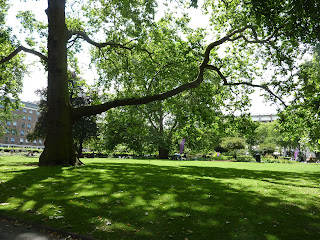Saturday and Sunday, 28-29 July
Our tickets to Olympic events are for next week, leaving us a free weekend to explore what London is like when hosting the rest of the world. Of course on any day of any ordinary week, London seems to be hosting the rest of the world since rarely do you overhear a word of English as you move through the city.
Londoners are funny people. They have been bemoaning the dislocations and the discomfort the Olympics will bring to daily life in the city pretty much since the day London was awarded the 2012 games. Many people seem to have made good on their promises to leave the day before the Olympics comes to town because London was blissfully empty over the weekend. In truth, this is not much different from a year without the Olympics. We love spending August in London because everyone has left for Devon or Dorset, Tuscany or Provence. Once you are away from the swarms of tourists in the West End, summer in London is pretty laid back.
Our first stop was the October Gallery in Bloomsbury which specialises in "cutting edge art from around the planet." The current exhibition is the work of Romuald Hazoumé from Benin considered one of Africa's most important contemporary artists according to the Gallery's press release. This exhibit is entitled Cargoland, and the exhibition booklet's interview with the artist explains that in Benin "cargo" is the term for a motorcycle refitted as a three wheeler in order to carry more containers of either petrol or water, the two vital fluids of life. The exhibit also addresses how the production of petrol in Nigeria, Benin's neighbour, has polluted the fresh water of the region, a situation which will ultimately make water, rather than petrol, the source of wealth for future fortune seekers. He points out this is hardly just a problem for Africa. For example, fracking may offer reduced cost natural gas, but create similar pollution and water supply issues. Who wants to answer the ethical question of commodifying water?
Through the wonders of the wonders of the web, you too can see the exhibit through the October Gallery's web page http://www.octobergallery.co.uk/artists/hazoume/index.shtml
Haroumé is best known for his masks made from found objects. Market life in his hometown Porto-Novo are featured in the panoramic photos. The plastic and glass containers that hold water and petrol are prominent in the market.
As we walked from the Gallery toward the Foundling Hospital Museum, we passed Great Ormond Street. Having just watched the Opening Ceremony in which Great Ormond Street Hospital, and its familiar smiling face logo and acronym GOSH, played a key role, I remembered reading during the Dickens birthday celebrations that the Victorian Chapel in the hospital is open to the public and well worth a stop. Charles Dickens saved the hospital from closure in its early days with generous donations.
Peter Pan frolics in the garden because J.M. Barrie left the rights and royalties for Peter Pan to Great Ormond Street, the first hospital devoted to the care of sick children. The hospital is still the place where the most seriously ill children are treated.
 |
| Brunswick Square in Bloomsbury once part of Captain Coram's Foundling Hospital grounds. |
We then decided to see if London was collapsing under the influx of Olympic visitors, and we found even ordinarily crowded spots like Kings Cross to be very quiet for a Saturday afternoon. A number of countries have set up National Hospitality Houses for their athletes and nationals in London, for commerce and trade delegations, and in some cases to welcome visitors.
 |
| Schnitzel and Dumplings, Austria at Trinity House |
 |
| Denmark had a Lego Olympic Stadium . . . |
 |
| . . . and a Lego Windmill at St Katharine's Dock |
The Gallery was built in 1901 to bring art to the residents of the impoverished East End. Plans for an Arts and Crafts style mosaic frieze to finish the façade never happened. The title is Tree of Life because there are tree motifs in the decoration of the side towers. There are certainly overtones of the Secession Building in Vienna.
Projects that enhance the East End have been a special part of the Cultural Olympiad because the upheaval of constructions has been borne by the East End residents. And there are influential cultural critics who feel the authenticity of the East End has been forever damaged by the incessant regeneration projects from the Isle of Dogs Canary Wharf to Stratford's Olympic Park. Last week's Persephone Post, a daily message of cultural uplift that starts my weekdays off right, was themed to the East End and included a link to the blog Spitalfields Life, an effort to record the street life and quirky characters in Spitalfields, an area better known now for hipsters and Tracy Emin. The Post recommended an exhibition at Christ Church Spitalfields by a local photographer who has been taking photos of his neighbours and neighbourhood since the late 1940s when he was a boy. Since we were nearby in Whitechapel, we walked over to see the exhibit. Many of the photos on display, and more, can be seen on the Spitalfields Life link.








No comments:
Post a Comment